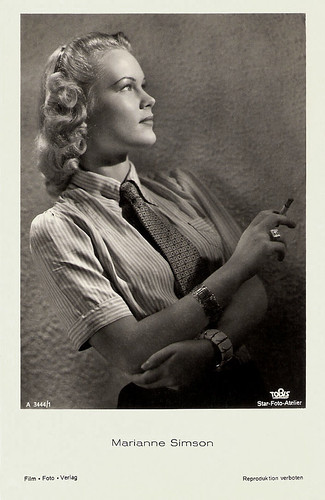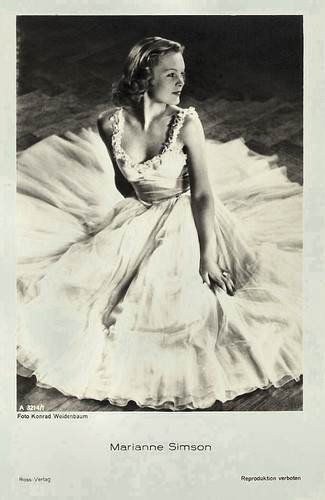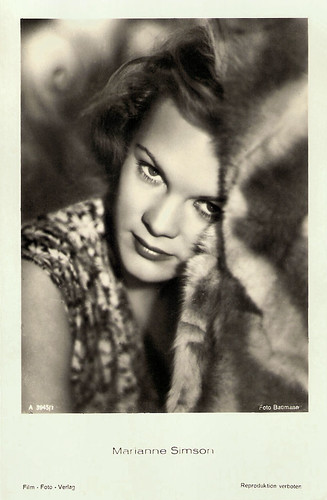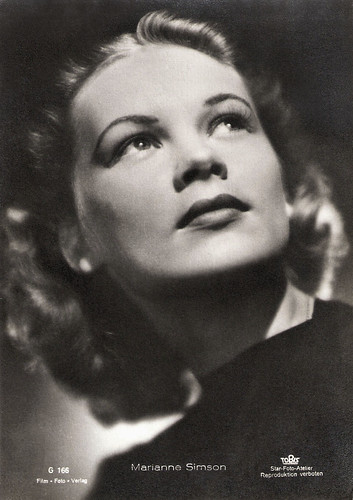German dancer and film actress Marianne Simson (1920-1992) appeared in 18 films between 1935 and 1945. Her film career took off during WW II. The sporty, beautiful blonde was cast in both musicals, historical adventures and dramas. Because of informing the Gestapo during the war, she was arrested after the war and sentenced to prison. After her release, she became a choreographer.

German postcard by Film-Foto-Verlag, no. A 3444/1, 1941-1944. Photo: Star-Foto-Atelier / Tobis.
Marianne Lena Elisabeth Clara Simson was born in Berlin in 1920. She was the daughter of an insurance clerk, John Edward Simson and his wife Frida née Kühl. Her brother was Helmut Simson, who after the war served as mayor of Wolfsburg.
She received an education in classical dance from Victor Gsovsky and in 1935, the young Simson became a dancer at the Nollendorftheater in Berlin. In 1936 she became a dancer at the Deutsche Opernhaus in Berlin and in 1939 at the Staatstheater under Gustaf Gründgens.
At the time, Marianne Simson was quite renowned as a ballerina, for example in 1941 a porcelain figurine was produced, depicting her on her toes. The figurine was reproduced in around 1957 by the company Rosenthal, and bears her name underneath.
As a teenager, Simson already made her screen debut in a supporting part in Friesennot/Frisians in Distress (Peter Hagen, 1935), made for Nazi propaganda purposes. The film drama concerns a Russian village of ethnic Frisians for whom the Soviet authorities make life as difficult as possible. After the Molotov–Ribbentrop Pact, in 1939, the film was banned. In 1941, after the invasion of Russia, it was again reissued under a new title.
After her first film appearance, Simson went on to play in another fifteen films over the next decade, generally in supporting roles. Three years after her debut, she appeared in the comedy Das Verlegenheitskind/The embarrassment child (Peter Paul Brauer, 1938) with Ida Wüst.
In 1939, she played in three films, the adventure Mann für Mann/Man for Man (Robert A. Stemmle, 1939) with Gisela Uhlen, Zentrale Rio/Central Río (Erich Engels, 1939) and the Fairy-tale Schneewittchen und die sieben Zwerge/Snowwhite and the Seven Dwarfs (Carl Heinz Wolff, 1939) in which she starred as Snowwhite. The following year, she had another leading role in the comedy Zwei Welten/Two Worlds (Gustaf Gründgens, 1940) with Antje Weisgerber and Joachim Brennecke.

German postcard by Ross Verlag, no. A 3214/1, 1941-1944. Photo: Konrad Weidenbaum.

German postcard by Film-Foto-Verlag, no. A 3945/1, 1941-1944. Photo: Baumann.
Marianne Simson’s film career took off during WW II. In 1941, she appeared in a supporting part in the musical Die schwedische Nachtigall/The Swedish Nightingale (Peter Paul Brauer, 1941), starring Ilse Werner and Joachim Gottschalk. It portrays a romance between the writer Hans Christian Andersen and the opera singer Jenny Lind, the ‘Swedish Nightingale’ of the title.
Simson played the second female lead romantic comedy Zwei in einer großen Stadt/Two in a Big City (Volker von Collande, 1942), starring Claude Farell and Karl John. John played a German soldier on leave in Berlin, who goes looking for his pen pal who he has never met called Gisela.
Simson then appeared in the historical drama Andreas Schlüter (Herbert Maisch, 1942), about the life of the eighteenth century German architect Andreas Schlüter portrayed by Heinrich George. Her next film, the comedy Das Bad auf der Tenne/The Bath in the Barn (Volker von Collande, 1943) was shot in Agfacolor, one of only a few German films made in colour during the war years.
Another example was the fantasy Münchhausen (Josef von Báky, 1943), featuring Hans Albers, in which Simson played the woman in the moon, maybe her best known part.
She then played one of the daughters of Henny Porten and Paul Westermeier in the family chronicle Familie Buchholz/The Buchholz Family (Carl Froelich, 1944) and the direct sequel Neigungsehe/Marriage of Affection (Carl Froelich, 1944), both set Berlin.
In 1943, Marianne Simson filed an application for membership in the NSDAP, which was rejected. In July 1944 she informed on Fritz Goes, an army major, to the Gestapo for allegedly making comments that were supportive of the 20 July plot to assassinate Adolf Hitler. Goes was subsequently imprisoned and tortured by the Gestapo for three months.
In the interrogation by the SS Obersturmbannführer Karl Radl (adjutant of Otto Skorzeny) and in the court hearing before a special court of the army, Simson maintained her testimony, which however was judged as unbelievable: statements by Viktor de Kowa, Anneliese Uhlig, the film producer Herbert Engelsing and General Jesco von Puttkamer provided for the acquittal of the defendant.
By that time she was rumoured to be Dr. Joseph Goebbels's lover and she complained to him about her denunciation. Following the defeat of Germany, Simson and her parents were arrested by the NKVD, the leading Soviet secret police organisation, and she was placed in a series of detention camps. There she was active in organising performances and giving song recitals.
In 1950 she was sentenced to eight years in prison, but was given an early release in 1952 and moved to West Germany. She played in a few TV films, and later worked as a choreographer in some stage productions. She married the theatre director Wilhelm List Diehl.
Marianne Simson passed away in 1992 in Füssen, Germany. She was 71.

German postcard by Film-Foto-Verlag, no. G 166, 1941-1944. Photo: Star-Foto-Atelier / Tobis.
Sources: Stephanie D’heil (Steffi-Line), Mart Sander (IMDb), Wikipedia (German and English), and IMDb.

German postcard by Film-Foto-Verlag, no. A 3444/1, 1941-1944. Photo: Star-Foto-Atelier / Tobis.
Nazi propaganda
Marianne Lena Elisabeth Clara Simson was born in Berlin in 1920. She was the daughter of an insurance clerk, John Edward Simson and his wife Frida née Kühl. Her brother was Helmut Simson, who after the war served as mayor of Wolfsburg.
She received an education in classical dance from Victor Gsovsky and in 1935, the young Simson became a dancer at the Nollendorftheater in Berlin. In 1936 she became a dancer at the Deutsche Opernhaus in Berlin and in 1939 at the Staatstheater under Gustaf Gründgens.
At the time, Marianne Simson was quite renowned as a ballerina, for example in 1941 a porcelain figurine was produced, depicting her on her toes. The figurine was reproduced in around 1957 by the company Rosenthal, and bears her name underneath.
As a teenager, Simson already made her screen debut in a supporting part in Friesennot/Frisians in Distress (Peter Hagen, 1935), made for Nazi propaganda purposes. The film drama concerns a Russian village of ethnic Frisians for whom the Soviet authorities make life as difficult as possible. After the Molotov–Ribbentrop Pact, in 1939, the film was banned. In 1941, after the invasion of Russia, it was again reissued under a new title.
After her first film appearance, Simson went on to play in another fifteen films over the next decade, generally in supporting roles. Three years after her debut, she appeared in the comedy Das Verlegenheitskind/The embarrassment child (Peter Paul Brauer, 1938) with Ida Wüst.
In 1939, she played in three films, the adventure Mann für Mann/Man for Man (Robert A. Stemmle, 1939) with Gisela Uhlen, Zentrale Rio/Central Río (Erich Engels, 1939) and the Fairy-tale Schneewittchen und die sieben Zwerge/Snowwhite and the Seven Dwarfs (Carl Heinz Wolff, 1939) in which she starred as Snowwhite. The following year, she had another leading role in the comedy Zwei Welten/Two Worlds (Gustaf Gründgens, 1940) with Antje Weisgerber and Joachim Brennecke.

German postcard by Ross Verlag, no. A 3214/1, 1941-1944. Photo: Konrad Weidenbaum.

German postcard by Film-Foto-Verlag, no. A 3945/1, 1941-1944. Photo: Baumann.
Joseph Goebbels's lover
Marianne Simson’s film career took off during WW II. In 1941, she appeared in a supporting part in the musical Die schwedische Nachtigall/The Swedish Nightingale (Peter Paul Brauer, 1941), starring Ilse Werner and Joachim Gottschalk. It portrays a romance between the writer Hans Christian Andersen and the opera singer Jenny Lind, the ‘Swedish Nightingale’ of the title.
Simson played the second female lead romantic comedy Zwei in einer großen Stadt/Two in a Big City (Volker von Collande, 1942), starring Claude Farell and Karl John. John played a German soldier on leave in Berlin, who goes looking for his pen pal who he has never met called Gisela.
Simson then appeared in the historical drama Andreas Schlüter (Herbert Maisch, 1942), about the life of the eighteenth century German architect Andreas Schlüter portrayed by Heinrich George. Her next film, the comedy Das Bad auf der Tenne/The Bath in the Barn (Volker von Collande, 1943) was shot in Agfacolor, one of only a few German films made in colour during the war years.
Another example was the fantasy Münchhausen (Josef von Báky, 1943), featuring Hans Albers, in which Simson played the woman in the moon, maybe her best known part.
She then played one of the daughters of Henny Porten and Paul Westermeier in the family chronicle Familie Buchholz/The Buchholz Family (Carl Froelich, 1944) and the direct sequel Neigungsehe/Marriage of Affection (Carl Froelich, 1944), both set Berlin.
In 1943, Marianne Simson filed an application for membership in the NSDAP, which was rejected. In July 1944 she informed on Fritz Goes, an army major, to the Gestapo for allegedly making comments that were supportive of the 20 July plot to assassinate Adolf Hitler. Goes was subsequently imprisoned and tortured by the Gestapo for three months.
In the interrogation by the SS Obersturmbannführer Karl Radl (adjutant of Otto Skorzeny) and in the court hearing before a special court of the army, Simson maintained her testimony, which however was judged as unbelievable: statements by Viktor de Kowa, Anneliese Uhlig, the film producer Herbert Engelsing and General Jesco von Puttkamer provided for the acquittal of the defendant.
By that time she was rumoured to be Dr. Joseph Goebbels's lover and she complained to him about her denunciation. Following the defeat of Germany, Simson and her parents were arrested by the NKVD, the leading Soviet secret police organisation, and she was placed in a series of detention camps. There she was active in organising performances and giving song recitals.
In 1950 she was sentenced to eight years in prison, but was given an early release in 1952 and moved to West Germany. She played in a few TV films, and later worked as a choreographer in some stage productions. She married the theatre director Wilhelm List Diehl.
Marianne Simson passed away in 1992 in Füssen, Germany. She was 71.

German postcard by Film-Foto-Verlag, no. G 166, 1941-1944. Photo: Star-Foto-Atelier / Tobis.
Sources: Stephanie D’heil (Steffi-Line), Mart Sander (IMDb), Wikipedia (German and English), and IMDb.
No comments:
Post a Comment